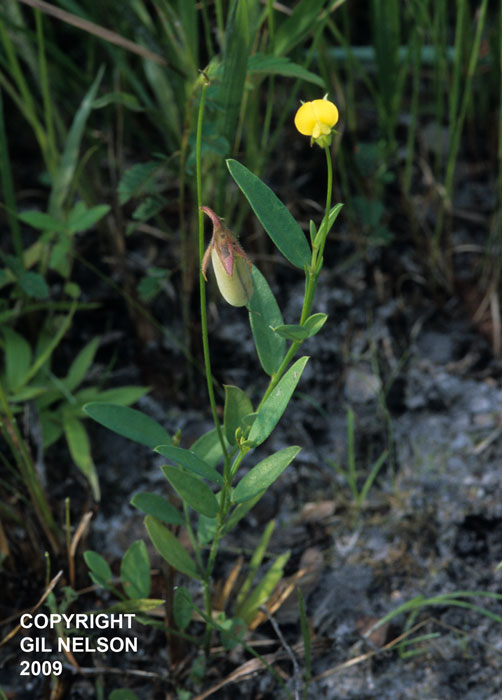Difference between revisions of "Crotalaria purshii"
| Line 24: | Line 24: | ||
===Habitat=== <!--Natural communities, human disturbed habitats, topography, hydrology, soils, light, fire regime requirements for removal of competition, etc.--> | ===Habitat=== <!--Natural communities, human disturbed habitats, topography, hydrology, soils, light, fire regime requirements for removal of competition, etc.--> | ||
It can live in temperatures ranging from 10 to 28 degrees Celsius with an average of 115 cm of rain annually.<ref name="Miller et al 1999">Miller, J. H. and K. V. Miller (1999). Forest plants of the southeast, and their wildlife uses Champaign, IL, Southern Weed Science Society.</ref> | It can live in temperatures ranging from 10 to 28 degrees Celsius with an average of 115 cm of rain annually.<ref name="Miller et al 1999">Miller, J. H. and K. V. Miller (1999). Forest plants of the southeast, and their wildlife uses Champaign, IL, Southern Weed Science Society.</ref> | ||
| − | It occurs in grassy pineland communities<ref name="Graham 1941"/> such as loblolly pine communities.<ref name="Miller et al 1999"> | + | It occurs in grassy pineland communities<ref name="Graham 1941"/> such as loblolly pine communities.<ref name="Miller et al 1999"/> |
===Phenology=== <!--Timing off flowering, fruiting, seed dispersal, and environmental triggers. Cite PanFlora website if appropriate: http://www.gilnelson.com/PanFlora/ --> | ===Phenology=== <!--Timing off flowering, fruiting, seed dispersal, and environmental triggers. Cite PanFlora website if appropriate: http://www.gilnelson.com/PanFlora/ --> | ||
Crotalaria purshii was observed flowering in sandhill and flatwood forests.<ref>Platt, W. J., Gregory W. Evans, and Mary M. Davis (1988). "Effects of Fires Season on Flowering of Forbs and Shurbs in Longleaf Pine Forests." Oecologia 76(3): 353-363.</ref> | Crotalaria purshii was observed flowering in sandhill and flatwood forests.<ref>Platt, W. J., Gregory W. Evans, and Mary M. Davis (1988). "Effects of Fires Season on Flowering of Forbs and Shurbs in Longleaf Pine Forests." Oecologia 76(3): 353-363.</ref> | ||
| Line 36: | Line 36: | ||
==Conservation and Management== | ==Conservation and Management== | ||
==Cultivation and restoration== | ==Cultivation and restoration== | ||
| + | ==Photo Gallery== | ||
==References and notes== | ==References and notes== | ||
| − | |||
Revision as of 11:56, 10 June 2015
| Crotalaria purshii | |
|---|---|

| |
| photo by Gil Nelson | |
| Scientific classification | |
| Kingdom: | Plantae |
| Division: | Magnoliophyta - Flowering plants |
| Class: | Magnoliopsida – Dicotyledons |
| Order: | Fabales |
| Family: | Fabaceae ⁄ Leguminosae |
| Genus: | Crotalaria |
| Species: | C. purshii |
| Binomial name | |
| Crotalaria purshii DC. | |

| |
| Natural range of Crotalaria purshii from USDA NRCS Plants Database. | |
Contents
Description
Distribution
Ecology
It is a legume.[1]
Habitat
It can live in temperatures ranging from 10 to 28 degrees Celsius with an average of 115 cm of rain annually.[2] It occurs in grassy pineland communities[1] such as loblolly pine communities.[2]
Phenology
Crotalaria purshii was observed flowering in sandhill and flatwood forests.[3]
Seed dispersal
Seed bank and germination
Fire ecology
Pollination
Use by animals
It is consumed by bobwhite quail.[1]
Diseases and parasites
Conservation and Management
Cultivation and restoration
Photo Gallery
References and notes
- ↑ 1.0 1.1 1.2 Graham, E. H. (1941). Legumes for erosion control and wildlife. Washington, USDA
- ↑ 2.0 2.1 Miller, J. H. and K. V. Miller (1999). Forest plants of the southeast, and their wildlife uses Champaign, IL, Southern Weed Science Society.
- ↑ Platt, W. J., Gregory W. Evans, and Mary M. Davis (1988). "Effects of Fires Season on Flowering of Forbs and Shurbs in Longleaf Pine Forests." Oecologia 76(3): 353-363.